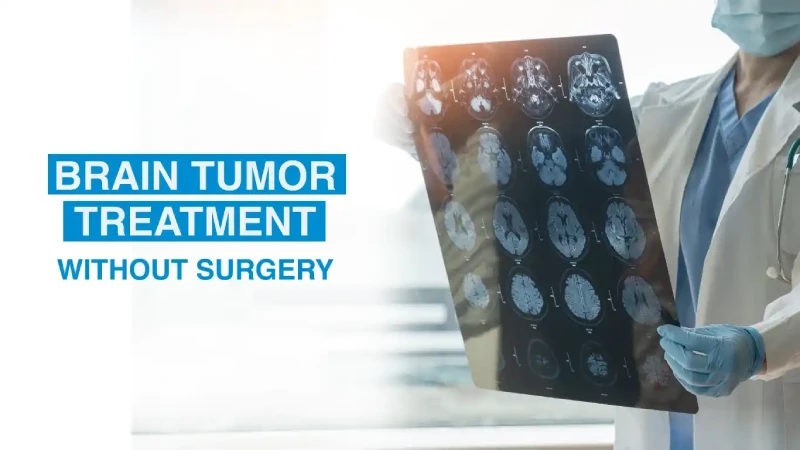
19 Dec, 2025
Feel free to reach out to us.

19 Dec, 2025

This article is medically reviewed by Dr. Meetu Jain, Consultant - Radiation Oncology, HCG Cancer Centre, Jaipur.
Brain tumors, both benign and malignant, are often treated with surgery. However, in some cases, surgery is not an option, especially when the tumor is deeply seated and spread to various parts of the brain, or the patient may not be in the state to undergo surgery. In such cases, other treatment options, such as radiotherapy, chemotherapy, and other systemic therapies, may be preferred.
In this article, we discuss the different treatment approaches for brain tumors that do not involve surgery.
A primary brain tumor originates within the brain itself. Benign (non-cancerous) and malignant (cancerous) tumors fall within this category. Examples include gliomas, meningiomas, and pituitary adenomas.
The kind of symptoms experienced depends on the tumor's location but often include headaches, seizures, changes in cognitive or behavioral patterns, and balance or vision disturbances.
A secondary brain tumor, or metastatic brain tumor, is a form of brain tumor that develops due to the spread of cancer cells from other locations to the brain. Primary cancers metastasizing to the brain usually include lung, breast, kidney, and melanoma.
It is often malignant and more aggressive than a primary brain tumor. The prognosis would vary with the stage of the primary cancer and the extent of brain involvement.
There is a misconception that brain tumors are untreatable. However, treatment depends on several factors, such as whether the tumor is benign or malignant, its location and size, and the patient's general health condition. Treatment options include surgery, chemotherapy, radiation therapy, immunotherapy, and targeted therapy.
Surgery is usually the first-line brain tumor medical procedure; however, this depends on whether the tumor can be safely removed. In cases where a surgeon does not expect to remove all of it, surgery might be followed by radiation therapy to decrease or control tumor growth.
Chemotherapy is recommended, particularly in the case of malignant brain tumors. Targeted therapies target one or more alterations at the genetic or protein level. Immunotherapy targets the body's immune system and helps it fight cancer cells.
In benign cases, the complete removal might result in a cure. However, close monitoring is required to monitor its recurrence. For malignant cases, the treatment is to regulate the growth of the disease, relieve symptoms, and prolong the life span, as long-term remission is not possible in all cases.
Some of the malignant and benign brain tumor treatment without surgery are:
Steroids are generally used to relieve symptoms associated with brain tumors. They do not treat the cancer itself but reduce the inflammation or edema surrounding it, thereby relieving the pressure inside the brain. This lowers the severity of various brain tumor symptoms, like headaches, nausea, and other neurological deficits.
Chemotherapy, a brain tumor treatment without surgery, is used for some brain tumors, especially malignant and aggressive brain tumors. Chemotherapy drugs for brain tumors can be delivered intrathecally through an ommaya reservoir, gliadel wafers, intravenously, or orally through capsules. These drugs help destroy brain tumor cells that divide rapidly.
Radiation therapy treats brain tumors without surgery. For some patients with brain tumors, surgery may not be an option because of tumor location or the patient’s age and health condition. In such cases, radiation therapy is recommended as a viable brain tumor treatment option. This approach involves targeting tumors from multiple angles with controlled doses of high-energy radiation. Radiation therapy to the brain is associated with various side effects, including tiredness, headaches, or issues with memory. However, technology has improved targeting and reduced the danger of long-term risk factors. Treatment is followed by scheduled follow-up appointments to determine the treatment response shown by the patient.
SRS, treatment for brain tumors without surgery, involves targeting and killing tumor cells in the brain through highly focused beams of radiation. It benefits small, well-defined tumors such as meningiomas, vestibular schwannomas, paragangliomas, and acoustic neuromas. Due to fewer adverse effects compared to conventional radiation therapy or surgery, the accuracy of SRS makes it an excellent option for tumors in sensitive or inoperable areas of the brain.
Cobalt-60 therapy is a form of radiation and is an alternative brain tumor treatment without surgery. During this procedure, gamma rays are emitted from a Cobalt-60 source to destroy the tumor. This treatment focuses an intense, precisely concentrated dose on the lesion with minimal damage to surrounding normal tissue. It is usually administered for small, discrete tumors like acoustic neuromas, meningiomas, and brain metastases.
Proton therapy is also a non-invasive brain tumor treatment option. This is an advanced radiation treatment approach for brain tumors. It uses protons (positively charged particles) to deliver high dose levels precisely in the tumor while limiting doses to surrounding healthy tissue. Radiation through proton therapy is effective for treating brain tumors present in sensitive areas, such as the near-brainstem or the optic nerve. Proton therapy is very effective in treating many types of brain tumors, including gliomas. Proton therapy is recommended for pediatric and adult patients with brain tumors.
Particle therapy is an advanced radiation therapy used as a treatment for brain tumors without surgery. It uses charged particles, such as protons, or heavier ions, like carbon ions. It is beneficial for sensitive brain parts to minimize damage to healthy tissues. Particle therapy has already been shown to be highly effective in treating a wide range of tumor types, such as gliomas and metastatic tumors.
Electro-field therapy, commonly known as tumor-treating fields (TTF), is an external brain tumor treatment without surgery involving low-intensity, intermediate-frequency electric fields. The mechanism behind this approach is the use of an electric field to disrupt the mitotic process of tumor cell proliferation and apoptosis, or cell death. TTF can be administered in association with other treatments, such as chemotherapy and radiation, most preferably used for cases of glioblastoma.
Targeted therapy is another way patients can receive treatment for brain tumors without surgery. It involves using chemotherapeutic agents or other substances that attack cancerous cells selectively, based on their uniqueness in genetic mutation or specific types of proteins. In contrast to chemotherapy, which damages all the rapidly dividing cells, targeted therapy aims to attack cancer cells only while reducing damage to healthy cells. Examples of commonly used targeted therapies include monoclonal antibodies and small-molecule inhibitors.
Proton therapy is also a non-invasive brain tumor treatment option. This is an advanced radiation treatment approach for brain tumors. It uses protons (positively charged particles) to deliver high dose levels precisely in the tumor while limiting doses to surrounding healthy tissue. Radiation through proton therapy is effective for treating brain tumors present in sensitive areas, such as the near-brainstem or the optic nerve. Proton therapy is very effective in treating many types of brain tumors, including gliomas. Proton therapy is recommended for pediatric and adult patients with brain tumors.
mTOR inhibitors are targeted therapy drugs used for the treatment of brain tumors without surgery. Inhibiting mTOR impacts cancer cells with interference in signaling, leading to restricted growth and increased death of tumor cells. It is especially effective in tumors with alterations in the mTOR pathway. Also, because of its synergistic effects with chemotherapy and radiation, it is often considered a helpful adjuvant.
Alternative and integrative medicine in treating brain tumors focuses more on complementary therapies that complement conventional treatments to promote healing and improve patient well-being. Practitioners include acupuncture, herbal supplements, nutritional therapy, and mindfulness practices, such as yoga and meditation. These techniques are not a replacement for standard medical care but, in many cases, help a patient overcome pain, anxiety, or fatigue.
Clinical trials play a role in advancements of brain tumor treatment since they provide patients with access to novel therapies and innovative approaches that are not yet available in standard care. These trials involve testing new drugs, treatment combinations, or novel delivery methods for their potential efficacy, side effects, and safety.
Symptomatic treatment aims to reduce symptoms caused by the tumor or its effects on other brain areas. These include headaches, seizures, nausea, and cognitive difficulty. Corticosteroids can reduce swelling and pressure, anticonvulsants can control seizures, and pain relievers can relieve headaches. Supportive therapies also include physical, occupational, and speech therapy. A patient may obtain psychological support and counseling to handle the emotional challenges. Symptomatic treatment is essential to enhance comfort and well-being in the comprehensive management of brain tumors.
HCG, which houses a robust team of brain tumor specialists, employs a comprehensive and multidisciplinary approach to treating brain tumors. It is known for its advanced diagnostic and treatment facilities, which include cutting-edge surgical techniques, targeted therapies, and radiation treatments. Patients receive personalized care according to their needs.
Experienced oncologists, neurosurgeons, and supportive care professionals are dedicated to providing holistic support throughout the treatment journey. HCG also emphasizes educating the patients regarding various treatment options so that they can make informed decisions.
Treatment of brain tumors is highly complex and depends on the type, size, location, and health of a patient. Both cancerous and non-cancerous brain tumor treatments without surgery include radiation therapy, chemotherapy, and targeted therapy.
Other types of nonsurgical treatments include electro-field therapy and angiogenesis inhibitors to improve the outcome of the treatment. The symptomatic treatments help improve the quality of life, and additional clinical trials are continually searching for novel therapies.

Author Bio : Dr. Meetu Jain
Consultant - Radiation Oncology
MBBS, MD
Dr. Meetu Jain is a highly skilled radiation oncology consultant who is available for consultations at HCG Cancer Centre, a leading hospital for cancer treatment in Jaipur. She has vast experience in treating a broad spectrum of cancers. She is an expert in administering radiation therapy through various approaches such as linear accelerators, brachytherapy, and cobalt teletherapy.
To book an appointment with Dr. Meetu Jain, please click here.
